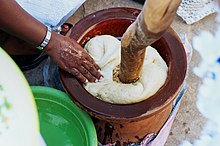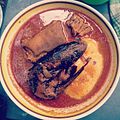Fufu
 | |
| Alternative names | Fufuo; foufou; foofoo; foutou; sakora; sakoro; couscous de Cameroun |
|---|---|
| Type | sticky dough |
| Place of origin | Ghana |
| Main ingredients | Usually cassava |
sadza; ugali | |
Fufu (or fufuo, foofoo, foufou
Although the original ingredients for fufu are boiled cassava, plantains, and cocoyam, yams (Ghana), it is also made in different ways in other West African countries. In Ghana, Ivory Coast and Liberia, they use the method of separately mixing and pounding equal portions of boiled cassava with green plantain or cocoyam, or by mixing cassava/plantains or cocoyam flour with water and stirring it on a stove. Its thickness is then adjusted to personal preference, and it is eaten with broth-like soups. In Nigeria, fufu (akpu) is made solely from fermented cassava giving it its unique thickness compared to that found in other west African countries. It is eaten with a variety of soups with vegetables and lots of beef and fish.[4] In recent years other flours, such as semolina, maize flour, or mashed plantains, may take the place of cassava flour. This is common for those in the diaspora or families that live in urban cities. Families in rural areas with access to farmland still maintain the original recipe of using cassava. Fufu is traditionally eaten with the fingers, and a small ball of it can be dipped into an accompanying soup or sauce.[5]
Names
- Angola: funge, fúngi
- Benin: santana, foufou
- Cameroon: couscous, couscous de manioc
- Central African Republic: foufou
- Congo-Brazzaville: fufú, moteke, luku
- Gabon: foufou
- Ghana: fufu, fufuo, sakɔro
- Guinea: foufou
- Haiti: tomtom
- Ivory Coast: foutou, foufou
- Liberia: fufu
- Mozambique: sadja, sadza, xima
- Nigeria: fufu, akpụ, ụtara, loi-loi, swallow
- Sierra Leone: foofoo
- Togo: foufou
In Africa
Before the Portuguese traders introduced cassava to Africa from Brazil in the 16th century, fufu was mainly made from cocoyam, plantain and yams.[6] The traditional method of eating fufu is to pinch some of the fufu off in one's right hand fingers and form it into an easily ingested round ball. The ball is then dipped in the soup before being eaten.
In Cote d'Ivoire
In Côte d'Ivoire, the word foutou is also used. Ivorian foufou is specifically mashed sweet plantains, whereas foutou is a stronger, heavier paste made of various staple foods such as yam, cassava, plantains, taro or a mix of any of those.
In the French-speaking regions of Cameroon, it is called "couscous" (not to be confused with the North African dish couscous).[7]
Although people from Eastern Africa and Southern Africa seem to confuse fufu (or fufuo) with their type of corn or maize dough dish called
In Ghana

It is believed to originate in what is now modern-day
In Nigeria
In
In the Caribbean
In Caribbean nations with substantial populations of West African origin (such as Cuba, Jamaica, the Dominican Republic, Haiti and Puerto Rico), plantains, cassava or yams are mashed with other ingredients.[citation needed] In Cuba, the dish retains its original African stem name, termed simply as fufú or with added descriptive extensions like fufú de plátano or fufú de plátano pintón.[22] In the Dominican Republic, a beloved dish, mangú, is very similar to fufú. On other major islands, fufú goes by the names of funche in Puerto Rico. What distinguishes the Caribbean "fufú" from its West African relative is a firmer texture with stronger flavors. As it moves away from Cuba, the fufú's core is less a gelatinous dough and more of a consistent mass.[23]
In Haiti it is called tonm tonm and foofoo. It is mostly made of breadfruit but can be made of plantain or yams and is usually served with an okra based stew or soup. It is primarily consumed in the southernmost regions of Haiti namely the Grand'Anse and Sud departments. The city of Jérémie is regarded as the tonmtonm capital of Haiti.
Puerto Rican mofongo, in keeping with the creolized cuisine traditions of the Caribbean, tends toward a fufú of much higher density and robust seasoning. While keeping a conspicuous African character, mofongo has borrowed from the island's Iberian culinary tradition, to create a dish made of fried green and yellow plantains, cassava or breadfruit. Unlike the mushier Caribbean and West African fufús, mofongo is generally firmer and crustier. To prepare mofongo, green plantains are deep-fried once unlike twice fried tostones. Next, they are mashed in a 'pilon' (mortar) with chopped garlic, salt, black pepper and olive oil. The resulting mash is then pressed and rounded into a hollowed crusty orb. Meat, traditionally chicharrón, is then stuffed into the chunky ball of fried green plantains. Some recipes call for a meat or vegetable salsa criolla" (related to American Creole sauce) poured atop the hot sphere. In the trendier "mofongo relleno", typical of western Puerto Rico, seafood is all over, inside and outside. Traditional mofongo, as previously cited, comes seasoned and stuffed with meat and bathed in a chicken broth soup.[24] Because of its elaborate process of preparation and its sundry ingredients, poet and blogger Arose N Daghetto called the mofongo a type of "fufú paella" and branded it as "the big daddy of fufús".[25] Although mofongo is associated with being fried, boiled and roasting plantain mofongo predate fried mofongo and is still excited but a rare find in Puerto Rico. A dish called funche made with taro, green and yellow plantains boiled and mashed with butter, garlic, and pork fat was once popular in Puerto Rico. Once mashed it was formed into balls and eaten with broth made from sesame seeds. Funche is written in early Puerto Rican cookbooks around the 1800s, but can probably be traced back to African slaves on the island. Funche today in Puerto Rico is cornmeal cooked in coconut milk and milk.
The vegetable or fufú sauce in the
Nutrition
Nutritionally, 100 g dry weight fufu contains 2 g of protein, 0.1 g of fat and 84 g of carbohydrates. There are 267 kcal of food energy in a 100 g serving made up with water.[26] It is low in cholesterol and rich in potassium, and it is commonly prescribed by doctors for people who have a low level of potassium in their blood.[27]
Gallery
-
A family eating fufu
-
A plate of fufu (right) accompanied by peanut soup
-
Fufu (left) andpalm nut soup(right)
-
Fufu
-
Nigerian food: fufu being sold on the street in Lagos
-
Wrapped fufu
-
Preparing fufu in Togo
-
Wooden pestle and mortar for pounding fufu
-
Fufu machine used by a food vendor
-
Pounded fufu
-
Fufu from Ghana
-
Ghanaian fufu with light soup, goat meat, and smoked fish
-
Fufu and light soup in asanka
See also
- African cuisine
- Ragi mudde
- Asida
- Attiéké
- Bazeen
- Congolese cuisine
- Eba
- Garri
- Grits
- Konkonte
- List of maize dishes
- Mămăliga
- Mangú
- Mashed potato
- Mochi
- Mofongo
- Plakali
- Poi
- Polenta
References
- OCLC 1241244901.)
{{cite book}}: CS1 maint: location missing publisher (link - ^ "5 Popular Swallows Eaten By Ghanaians". Modern Ghana. Retrieved 2022-05-03.
- ^ Victoria, Akinola (2022-04-24). "5 Nigerian meals that have similar versions across African countries". Pulse Nigeria. Retrieved 2022-05-03.
- ^ Nweke, Felix I. "THE CASSAVA TRANSFORMATION IN AFRICA". United Nations. Retrieved 10 June 2014.
- ^ "What is Fufu, the West African Delicacy?". www.finedininglovers.com. Retrieved 2022-09-17.
- ^ "A review of cassava in Africa with country case studies on Nigeria, Ghana,the United Republic of Tanzania, Uganda and Benin". www.fao.org. Retrieved 2018-04-22.
- ^ DeLancey, Mark W., and Mark Dike DeLancey (2000). Historical Dictionary of the Republic of Cameroon, 3rd ed. Lanham, Maryland: The Scarecrow Press, p. 134.
- ^ Siciliano-Rosen, L. "Fufu." Encyclopedia Britannica.https://www.britannica.com/topic/fufu
- ^ Britannica, The Editors of Encyclopædia (April 22, 2024). "Akan People". Britannica.
{{cite web}}:|first=has generic name (help) - ^ Miller (2022), p. 89
- ^ "Top 5 healthy meals to enjoy when in Ghana - MyJoyOnline.com". www.myjoyonline.com. 2015-11-26. Retrieved 2022-01-22.
- ISBN 9589439896.
- ISBN 978-0-385-47454-2.
- ^ Miller (2022), p. 111
- ^ "cassava".
- ^ "HOW TO MAKE WATER FUFU FROM SCRATCH - CASSAVA FUFU". Precious Core. 2017-07-14. Retrieved 2022-05-12.
- ^ "How To Make Fufu From Scratch (Nigerian Fufu)". My Active Kitchen. 2021-02-17. Retrieved 2022-05-12.
- ^ "Accelerate Tv - Under Maintenance". acceleratetv.com. Retrieved 2022-05-12.[permanent dead link]
- ^ "Processing of akpu/fufu Recipe by Emryson's Kitchen". Cookpad. 9 January 2019. Retrieved 2022-05-12.
- ^ "Akpu Cassava Fufu Recipe:: Nigerian Dishes :: Galleria Health and Lifestyle, Nigeria". www.nigeriagalleria.com. Retrieved 2018-05-05.
- ^ "cassava".
- ISBN 978-0307595430.
- ISBN 9781401306120.
- ^ Food and Identity in the Caribbean, Hanna Garth, Ed. 2013 Bloomsbury Press.
- ^ Daghetto, Arose N. (2011). "Say Whaaat??– Fufu and Mofongo!". Article. Literature Voodoo-- Quite Storm Enterprises. Retrieved December 17, 2015.
- ^ "How many calories are in Golden Tropics Cocoyam Fufu Flour". slimkicker.com. SlimKicker. 2013. Retrieved 2 July 2014.
- ^ Health, Public (2020-09-10). "Health Benefits and Side Effects of Eating Fufu - Public Health". Retrieved 2022-09-17.
Bibliography
- Miller, Brandi Simpson (2022). Food and Identity in Nineteenth and Twentieth Century Ghana: Food, Fights, and Regionalism. ISBN 9783030884031.
External links
- "Ghana's cooks take to fast fufu". BBC News. 2006-05-29. Retrieved August 5, 2008. Microwavable instant fufu.













